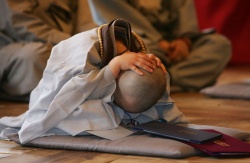Difference between revisions of "Four Indian castes"
(Created page with "thumb|250px| <poem> '''four Indian castes''' (四姓). These are (1) Brahmin (priest), (2) kṣatriya (royalty and warrior), (3) vaiśya (farmer ...") |
|||
| Line 2: | Line 2: | ||
<poem> | <poem> | ||
'''four Indian castes''' (四姓). These are | '''four Indian castes''' (四姓). These are | ||
| − | (1) Brahmin (priest), | + | (1) [[Brahmin]] (priest), |
(2) kṣatriya (royalty and warrior), | (2) kṣatriya (royalty and warrior), | ||
(3) vaiśya (farmer and merchant), and | (3) vaiśya (farmer and merchant), and | ||
(4) śūdra (serf). | (4) śūdra (serf). | ||
| − | The Buddha ruled that all from the four castes would be allowed to become Buddhist śramaṇas as the fifth | + | [[The Buddha]] ruled that all from the four castes would be allowed to become Buddhist śramaṇas as the fifth [[Caste]], the highest of all castes. |
| + | |||
| + | When Ywan Chwang traveled to South India after the period of the Chalukyan Empire, he noticed that the caste system had existed among the Buddhists and Jains. | ||
| + | |||
| + | Buddhism in India, like other religions, has attempted to reform and create a society without classes. Nevertheless, in some parts of India such a Ladakh, with significant historical presence of Buddhists, a caste system existed in a manner similar to caste structure in Tibet. The upper castes belonged to ''sger gzhis'', and were called ''sgar pa''. The priestly caste belonged to monastery, and were called ''chos-gzhis''. Miser were the serf caste. Serfs, the majority of the people, farmed and paid taxes. An individual's social status and lifelong occupation was destined by birth, closed, and depending on the family one was born into, the individual inherited a tenure document known as ''khral-rten''. Buddhist castes had sub-castes, such as ''nang gzan'', khral pa and ''dud chung''. Buddhist also had castes that were shunned by their community and ostracized, such as hereditary fishermen, butchers and undertakers. The untouchables in Buddhist regions, as in Tibet, were known as Ragyappa, who lived in isolated ghettos, and their occupation was to remove corpses (human or animal) and dispose of sewage. | ||
</poem> | </poem> | ||
{{R}} | {{R}} | ||
Revision as of 08:25, 7 May 2013
four Indian castes (四姓). These are
(1) Brahmin (priest),
(2) kṣatriya (royalty and warrior),
(3) vaiśya (farmer and merchant), and
(4) śūdra (serf).
The Buddha ruled that all from the four castes would be allowed to become Buddhist śramaṇas as the fifth Caste, the highest of all castes.
When Ywan Chwang traveled to South India after the period of the Chalukyan Empire, he noticed that the caste system had existed among the Buddhists and Jains.
Buddhism in India, like other religions, has attempted to reform and create a society without classes. Nevertheless, in some parts of India such a Ladakh, with significant historical presence of Buddhists, a caste system existed in a manner similar to caste structure in Tibet. The upper castes belonged to sger gzhis, and were called sgar pa. The priestly caste belonged to monastery, and were called chos-gzhis. Miser were the serf caste. Serfs, the majority of the people, farmed and paid taxes. An individual's social status and lifelong occupation was destined by birth, closed, and depending on the family one was born into, the individual inherited a tenure document known as khral-rten. Buddhist castes had sub-castes, such as nang gzan, khral pa and dud chung. Buddhist also had castes that were shunned by their community and ostracized, such as hereditary fishermen, butchers and undertakers. The untouchables in Buddhist regions, as in Tibet, were known as Ragyappa, who lived in isolated ghettos, and their occupation was to remove corpses (human or animal) and dispose of sewage.
